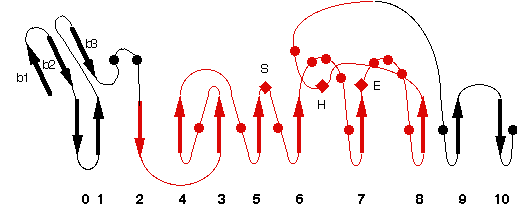8AM2
Name : Human butyrylcholinesterase in complex with 2,2'-(((1E,1'E)-(2-phenylpyrimidine-4,6-diyl)bis(methaneylylidene))bis(hydrazin-1-yl-2-ylidene))bis(N,N,N-trimethyl-2-oxoethan-1-aminium)
Revelation date : 14-Jun-2023
Family : BCHE
Gene_locus : human-BCHE
PDB file : ESTHER: header of PDB entry RCSB: Full entry
Comment
Nachon, F.,Brazzolotto, X.,Dias, J.
Ligand :
References (1)
| Title : Grid-type Quaternary Metallosupramolecular Compounds Inhibit Human Cholinesterases through Dynamic Multivalent Interactions - Nachon_2022_Chembiochem_23_e202200456 |
| Author(s) : Nachon F , Brazzolotto X , Dias J , Courageux C , Drozdz W , Cao XY , Stefankiewicz AR , Lehn JM |
| Ref : Chembiochem , 23 :e202200456 , 2022 |
| Abstract : Nachon_2022_Chembiochem_23_e202200456 |
| ESTHER : Nachon_2022_Chembiochem_23_e202200456 |
| PubMedSearch : Nachon_2022_Chembiochem_23_e202200456 |
| PubMedID: 36193860 |
| Gene_locus related to this paper: human-BCHE |
Representative scheme of Prolylcarboxypeptidase structure and an image from PDBsum server

